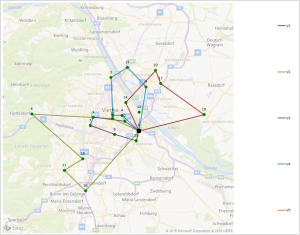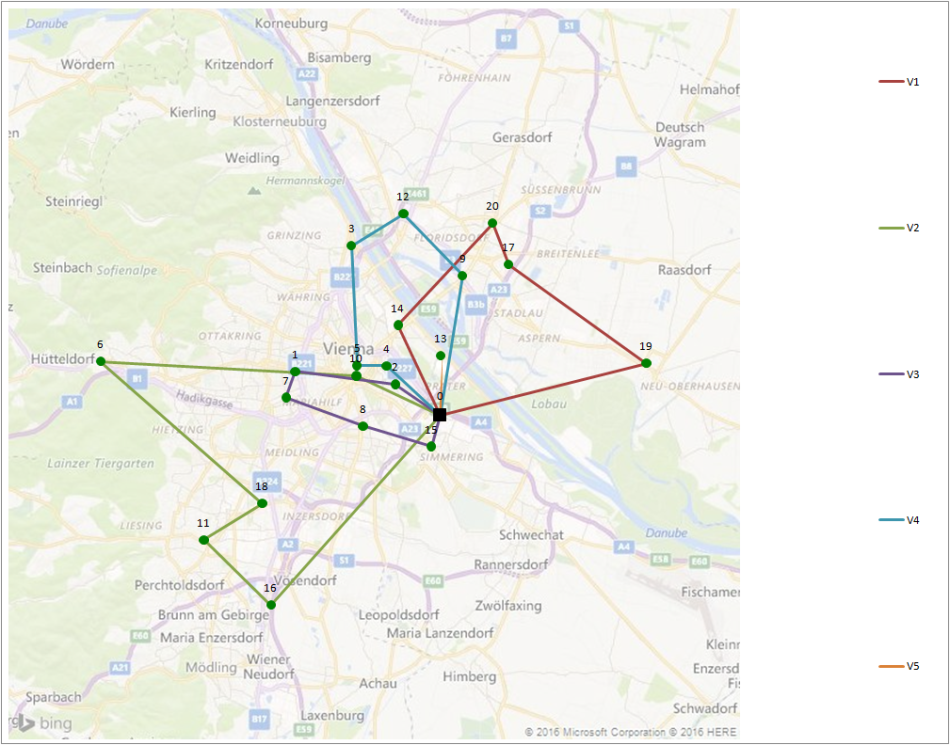During a research stay in Barcelona, I came across an interesting talk (Ramalhinho and Grasas, 2013) on teaching vehicle routing problems (VRPs) in graduate business school. The main idea is quite simple: let the students solve a small VRP manually. They can use any electronic sources of their choice (e.g., GoogleMaps, BingMaps, ArcMap). Afterwards, problems are discussed and results compared to show strengths of optimization procedures and routing software systems. This year, I had the opportunity to teach graduate students in supply chain management and tried a similar approach.
Instead of routing vehicles in Barcelona, I developed multiple small exercises for Vienna, Austria. Each one includes 20 stops with varying delivery amounts and a maximum capacity per vehicle. For locations, major shopping centers or tourist attractions in the city were used. No time-windows or other constraints are included. Students had 60 minutes time to solve the problem. The in-class results and main observations of one instance are shown below:

Group Results:
- Solution of VRP spreadsheet solver: 167.07
- Best group: 189.12 (+13.20%)
- Average: 215.26 (+28.84%)
- Worst: 308.40 (+84.60%)
Observations:
- Most groups simplified the problem by using a clustering method.
- Some groups started solving a TSP and then tried to split the routes.
- None of the group visualized the results to search for improvements.
- Out of the 7 groups, only a single group created more than a single solution.
To visualize results and to show the strength of routing software, the open-source VRP spreadsheet solver by Güneş Erdoğan (see link in references) was used. Additionally, after completion of the manual planning tasks, the whole class together used the spreadsheet solver to derive an optimized solution. Consequently, students got an understanding for the complexity of planning tasks as well as the advantages of routing software systems and automated data collection. Additionally, common complications such as data errors, incomplete addresses and lack of real-time traffic flow data were discussed.
Update 2020:
Due to the COVID-19 crisis, the course was held this year via MS Teams in a distance-based learning setting. While it is was obviously difficult to supervise students and see their different approaches to solve the problem this way, the game was nevertheless a success and received positive feedback.
References
- Ramalhinho, H. and Grasas, A. (2013) Teaching VRP in Business Schools. UPF-Barcelona GSE, Presentation at Euro2013, available online at http://lena.upf.edu/wp-content/uploads/2015/06/EURO_2013.pdf (accessed 07.12.2016)
- Erdoğan, G. (2013) VRP Spreadsheet Solver. Available online at http://people.bath.ac.uk/ge277/index.php/vrp-spreadsheet-solver/ (accessed 25.11.2017)
- Erdoğan, G. (2017) An open source Spreadsheet Solver for Vehicle Routing Problems. Computers & Operations Research 84: 62–72.

0 comments on “In-class Assignment to Teach Vehicle Routing Problems in Business Schools”